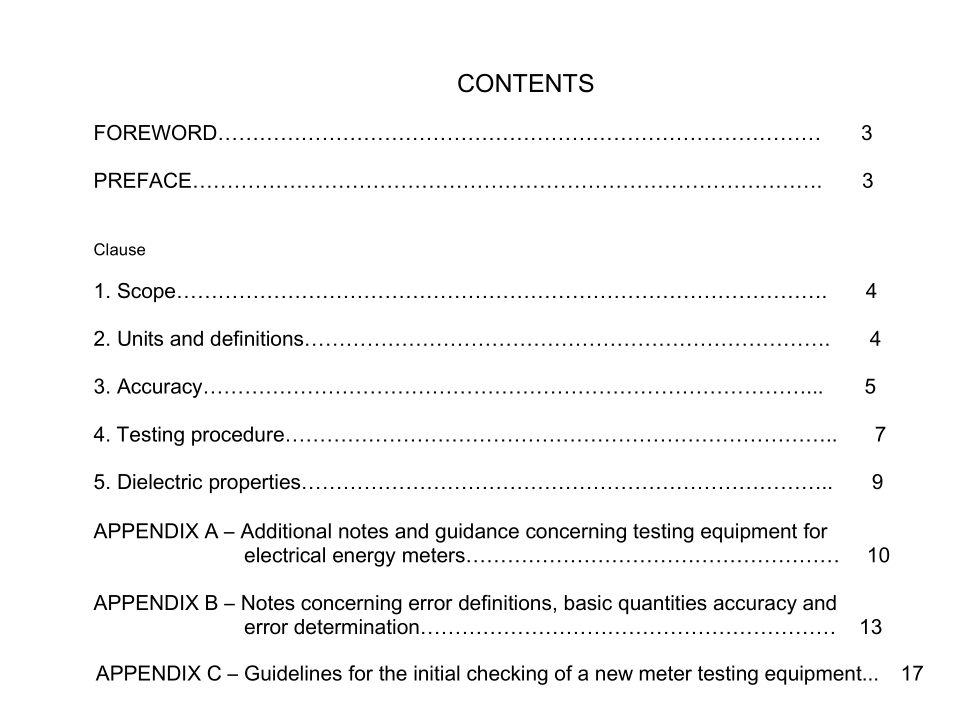BS IEC 60736 pdf download

BS IEC 60736 pdf download.Testing equipment for electrical energy meters
2. Units and definitions
The units used in this report are those used by the International Electrotechnical Commission (IEC). . 2.1 Testing equipment for electrical energy meters; meter testing equipment (MTE) An assembly of apparatus to supply energy to meters under test and to measure this energy. 2.2 Power x time measurement method (wattmeter method) A method by which the energy supplied to the meter(s) under test is determined by the product of a known constant power and a known interval of time. 2.3 Energy comparison method (standard meter method) A method by which a known amount of energy is supplied to the meter(s) under test. 2.4 Reference standard A standard with which standards of lower accuracy are compared. 2.5 Working standard A standard which, calibrated against a reference standard, is intended to verify working measuring instruments of lower accuracy. 2.6 MTE test standard A measuring device for the determination of the accuracy of an MTE. It always includes a reference standard. It may include other elements, for example precision instrument trans- formers, precision time interval generator, etc.
3. Accuracy
3.1 General remarks An MTE shall allow the user to adjust and measure the necessary quantities, voltage, current, power-factor, time, power and energy within the permissible tolerances for the relevant class of meters which will be tested with this MTE. The error E of an MTE is the overall error of all its components under normal service conditions. 3.2 Methods for the determination of the overall error of an MTE The determination of the overall error of an MTE is made according to the following methods: – comparison of the energy delivered at the output terminals of the MTE indicated by the MTE test standard with the energy indicated by the working standard(s) of the MTE; – comparison of the power at the output terminals of the MTE, indicated by the MTE test standard, with the power indicated by the working standard(s) of the MTE. The influence of the accuracy of the time measurement on the error of the energy shall be specified. 3.3 Reference conditions The reference conditions at the input of the MTE shall be specified by the manufacturer and shall be such that, at its output, the reference conditions for the meter(s) under test are fulfilled. Sub-clause 3.4 gives the particular requirements for the magnetic field produced by the MTE. 3.5 Error determination of an MTE The error of a newly manufactured MTE at a certain test point shall be lower than the error Emax in Table I (see Clause BI of Appendix B for the error definition). If the result of a single measurement gives an error in excess of the permissible limits, then two additional measurements at this particular test point can be taken. The results of these two additional measurements shall be within the permissible limits of Emax. An MTE is capable of being used at least for meters of the relevant class (type test or acceptance inspection) according to Table I, if the results of all test points (Table III) are within the limits of the permissible errors. If the results of some test points are not within the limits of the permissible errors, the use of this MTE may be restricted to certain ranges, for certain classes of meters. Such a restriction shall be indicated in a suitable visible place on this MTE. 3.6 Correction of the error E of an MTE If the error E of an MTE in service is outside the limits of Table I but within twice the relevant values of Table I then a correction for the error of the MTE shall be applied to the results of the tests on the meter(s) under test. In these cases, it is recommended that an effort should be made to reduce the error of the MTE in order to bring it within the permissible limits.









